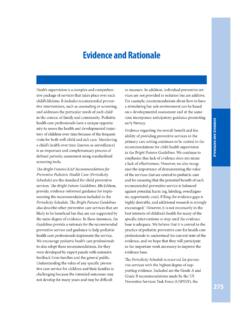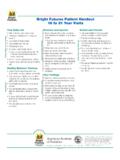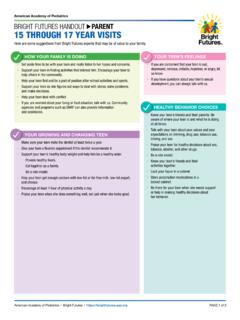Transcription of BRIGHT FUTURES HANDOUT PARENT 2 YEAR VISIT
1 HOW YOUR FAMILY IS DOING Take time for yourself and your partner. Stay in touch with friends. Make time for family activities. Spend time with each child. Teach your child not to hit, bite, or hurt other people. Be a role model. If you feel unsafe in your home or have been hurt by someone, let us know. Hotlines and community resources can also provide confidential help. Don t smoke or use e-cigarettes. Keep your home and car smoke-free. Tobacco-free spaces keep children healthy. Don t use alcohol or drugs. Accept help from family and friends. If you are worried about your living or food situation, reach out for help. Community agencies and programs such as WIC and SNAP can provide information and assistance. TALKING AND YOUR CHILD Use clear, simple language with your child.
2 Don t use baby talk. Talk slowly and remember that it may take a while for your child to respond. Your child should be able to follow simple instructions. Read to your child every day. Your child may love hearing the same story over and over. Ta l k a b o u t a n d d e s c r i b e p i c t u r e s i n b o o k s . Talk about the things you see and hear when you are together. Ask your child to point to things as you read. Stop a story to let your child make an animal sound or finish a part of the FUTURES HANDOUT PARENT 2 YEAR VISITHere are some suggestions from BRIGHT FUTURES experts that may be of value to your Academy of Pediatrics YOUR CHILD S BEHAVIOR Praise your child when he does what you ask him to do. Listen to and respect your child. Expect others to as well.
3 Help your child talk about his feelings. Watch how he responds to new people or situations. Read, talk, sing, and explore together. These activities are the best ways to help toddlers learn. Limit TV, tablet, or smartphone use to no more than 1 hour of high-quality programs each day. It is better for toddlers to play than to watch TV. Encourage your child to play for up to 60 minutes a day. Avoid TV during meals. Talk together Academy of Pediatrics | BRIGHT FUTURES | PAGE 1 of 2 Helpful Resources: National Domestic Violence Hotline: 800-799-7233 | Smoking Quit Line: 800-784-8669 Information About Car Safety Seats: | Toll-free Auto Safety Hotline: 888-327-4236 TOILET TRAINING Begin toilet training when your child is ready. Signs of being ready for toilet training include Staying dry for 2 hours Knowing if she is wet or dry Can pull pants down and up Wanting to learn Can tell you if she is going to have a bowel movement Plan for toilet breaks often.
4 Children use the toilet as many as 10 times each day. Teach your child to wash her hands after using the toilet. Clean potty-chairs after every use. Take the child to choose underwear when she feels ready to do from on 01/29/2019 Terms of use: TO EXPECT AT YOUR CHILD S 2 YEAR VISITWe will talk about Creating family routines Supporting your talking child Getting along with other children Getting ready for preschool Keeping your child safe at home, outside, and in the carAmerican Academy of Pediatrics | BRIGHT FUTURES | PAGE 2 of 2 The information contained in this HANDOUT should not be used as a substitute for the medical care and advice of your pediatrician. There may be variations in treatment that your pediatrician may recommend based on individual facts and circumstances.
5 Original HANDOUT included as part of the BRIGHT FUTURES Tool and Resource Kit, 2nd Edition. Inclusion in this HANDOUT does not imply an endorsement by the American Academy of Pediatrics (AAP). The AAP is not responsible for the content of the resources mentioned in this HANDOUT . Web site addresses are as current as possible but may change at any American Academy of Pediatrics (AAP) does not review or endorse any modifications made to this HANDOUT and in no event shall the AAP be liable for any such changes. 2019 American Academy of Pediatrics. All rights YEAR VISIT PARENT SAFETY Make sure your child s car safety seat is rear facing until he reaches the highest weight or height allowed by the car safety seat s manufacturer. Once your child reaches these limits, it is time to switch the seat to the forward-facing position.
6 Make sure the car safety seat is installed correctly in the back seat. The harness straps should be snug against your child s chest. Children watch what you do. Everyone should wear a lap and shoulder seat belt in the car. Never leave your child alone in your home or yard, especially near cars or machinery, without a responsible adult in charge. When backing out of the garage or driving in the driveway, have another adult hold your child a safe distance away so he is not in the path of your car. Have your child wear a helmet that fits properly when riding bikes and trikes. If it is necessary to keep a gun in your home, store it unloaded and locked with the ammunition locked with BRIGHT FUTURES : Guidelines for health supervision of Infants, Children, and Adolescents, 4th EditionFor more information, go to from on 01/29/2019 Terms of use: you know that injuries are the leading cause of death of children younger than 4 years in the UnitedStates?
7 Most of these injuries can be prevented. Often, injuries happen because parents are not aware of what their children can do. Children learn fast, and before you know it your child will bejumping, running, ridinga tricycle, and using child is at special risk for injuries from falls, drowning, poisons, burns, and car crashes. Your child doesn t understand dangers or remember no while playing and your child s abilities are so great now, he or she will find an endless variety of dangerous situations at home and in the child can fall off play equipment, out of windows, down stairs, off a bike or tricycle, and off anything that can be climbed on. Be sure the surface under play equipment is soft enough to absorb a safety-tested mats or loose-fill materials (shredded rubber, sand, wood chips, or bark) maintained to a depth of at least 9 inches underneath play equipment.
8 Install the protective surface at least 6 feet (more for swings and slides) in all directions from the the doors to any dangerous areas. Use gates on stairways and install operable window guards above the first floor. Fence in the play yard. If your child has a serious fall or does not act normally after a fall, call your HazardsChildren in homes where guns are present are in more danger of being shot by themselves, their friends, or family members than of being injured by an intruder. It is best to keep all guns out of the home. If you choose to keep a gun, keep it unloaded and in a locked place, with the ammunition locked separately. Handguns are especially dangerous. Ask if the homes where your child visits or is cared for have guns and how they are kitchen can be a dangerous place for your child, especially when you are cooking.
9 If your child is underfoot, hot liquids, grease, and hot foods can spill on him or her and cause serious burns. Find something safe for your child to do while you are that kitchen appliances and other hot surfaces such as irons, ovens, wallheaters, and outdoor grills can burn your child long after you have finished using to 4 Years2 TO 4 YEARSS afety for Your Child(over)If your child does get burned, immediately put cold water on the burned area. Keep the burned area in coldwater for a few minutes to cool it off. Then cover the burn loosely with a dry bandage or clean cloth. Callyour doctor for all burns. To protect your child from tap water scalds, the hottest temperature at the faucetshould be no more than 120 F. In many cases you can adjust your water sure you have a working smoke alarm on every level of your home, especially in furnace and sleeping s t t h e a l a r m s e v e r y m o n t h.
10 I t i s b e s t t o u s e s m o k e a l a r m s t h a t u s e l o n g - l i f e b a t t e r i e s , b u t i f y o u d o n o t , c h a n g e the batteries at least once a child will be able to openany drawer and climbanywhere curiosity leads. Your child may swallow anythinghe or she finds. Use only household products and medicines that are absolutely necessary and keep them safely capped and out of sight and reach. Keep all products in their original your child does put something poisonous in his or her mouth, call the Poison Help Lineimmediately. Attach the Poison Help Line number (1-800-222-1222) to your phone. Do not make your child Remember Car SafetyCar crashesare the greatest dangerto your child s life and health . The crushing forces to your child s brain and body in a collision or sudden stop, even at low speeds, can cause injuries or death.




